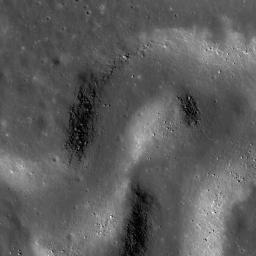Sinuous rille winding its way across a much larger rille in the heart of the Aristarchus Plateau, image width 1.76 km.
Vallis Schröteri, the largest rille on the Moon, originates on the Aristarchus Plateau and is comprised of three key morphologic features (below): the Cobra Head, the primary rille (155 km long), and the inner rille (204 km long). Rilles are believed to have formed as large volumes of very fluid magma erupted and flowed rapidly from the vent. Scientists are not certain how rilles are formed - that's one of many questions that future human lunar explorers will answer. Experts currently think that molten lava may carve a channel into the lunar surface (erosional model), or levees may form at the margins of the flow confining it (constructional model). Some lunar sinuous rilles may have started as collapsed lava tubes and were later modified to their final form. Lunar sinuous rilles do form by volcanic eruptions, but the details of how they get their "river-like" shape are also a mystery. The LROC NAC frame (above) shows a section of the inner rille about halfway down its length where it is about 600 m wide and the primary rille about 4300 m. LROC will provide high resolution stereo images of many lunar rilles to help scientists discriminate between the competing models of formation. The geologic complexity of Aristarchus Plateau and its rich, easily accessible deposits of potential resources make it an exciting landing site for future human exploration missions.
NASA's Goddard Space Flight Center built and manages the mission for the Exploration Systems Mission Directorate at NASA Headquarters in Washington. The Lunar Reconnaissance Orbiter Camera was designed to acquire data for landing site certification and to conduct polar illumination studies and global mapping. Operated by Arizona State University, the LROC facility is part of the School of Earth and Space Exploration (SESE). LROC consists of a pair of narrow-angle cameras (NAC) and a single wide-angle camera (WAC). The mission is expected to return over 70 terabytes of image data.

 Planetary Data System
Planetary Data System












